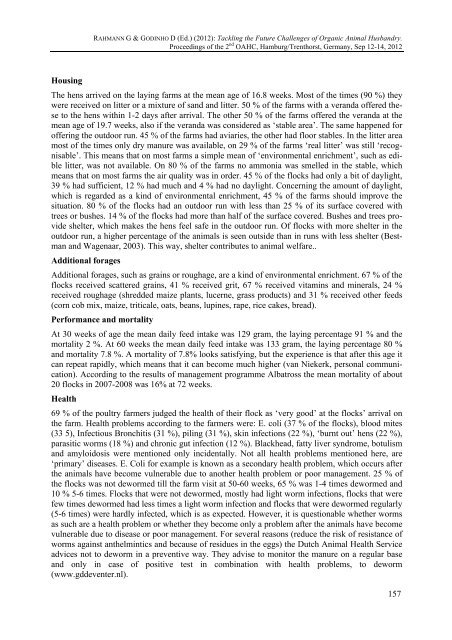Tackling the future challenges of Organic Animal Husbandry - vTI
Tackling the future challenges of Organic Animal Husbandry - vTI
Tackling the future challenges of Organic Animal Husbandry - vTI
Create successful ePaper yourself
Turn your PDF publications into a flip-book with our unique Google optimized e-Paper software.
RAHMANN G & GODINHO D (Ed.) (2012): <strong>Tackling</strong> <strong>the</strong> Future Challenges <strong>of</strong> <strong>Organic</strong> <strong>Animal</strong> <strong>Husbandry</strong>.<br />
Proceedings <strong>of</strong> <strong>the</strong> 2 nd OAHC, Hamburg/Trenthorst, Germany, Sep 12-14, 2012<br />
Housing<br />
The hens arrived on <strong>the</strong> laying farms at <strong>the</strong> mean age <strong>of</strong> 16.8 weeks. Most <strong>of</strong> <strong>the</strong> times (90 %) <strong>the</strong>y<br />
were received on litter or a mixture <strong>of</strong> sand and litter. 50 % <strong>of</strong> <strong>the</strong> farms with a veranda <strong>of</strong>fered <strong>the</strong>se<br />
to <strong>the</strong> hens within 1-2 days after arrival. The o<strong>the</strong>r 50 % <strong>of</strong> <strong>the</strong> farms <strong>of</strong>fered <strong>the</strong> veranda at <strong>the</strong><br />
mean age <strong>of</strong> 19.7 weeks, also if <strong>the</strong> veranda was considered as ‘stable area’. The same happened for<br />
<strong>of</strong>fering <strong>the</strong> outdoor run. 45 % <strong>of</strong> <strong>the</strong> farms had aviaries, <strong>the</strong> o<strong>the</strong>r had floor stables. In <strong>the</strong> litter area<br />
most <strong>of</strong> <strong>the</strong> times only dry manure was available, on 29 % <strong>of</strong> <strong>the</strong> farms ‘real litter’ was still ‘recognisable’.<br />
This means that on most farms a simple mean <strong>of</strong> ‘environmental enrichment’, such as edible<br />
litter, was not available. On 80 % <strong>of</strong> <strong>the</strong> farms no ammonia was smelled in <strong>the</strong> stable, which<br />
means that on most farms <strong>the</strong> air quality was in order. 45 % <strong>of</strong> <strong>the</strong> flocks had only a bit <strong>of</strong> daylight,<br />
39 % had sufficient, 12 % had much and 4 % had no daylight. Concerning <strong>the</strong> amount <strong>of</strong> daylight,<br />
which is regarded as a kind <strong>of</strong> environmental enrichment, 45 % <strong>of</strong> <strong>the</strong> farms should improve <strong>the</strong><br />
situation. 80 % <strong>of</strong> <strong>the</strong> flocks had an outdoor run with less than 25 % <strong>of</strong> its surface covered with<br />
trees or bushes. 14 % <strong>of</strong> <strong>the</strong> flocks had more than half <strong>of</strong> <strong>the</strong> surface covered. Bushes and trees provide<br />
shelter, which makes <strong>the</strong> hens feel safe in <strong>the</strong> outdoor run. Of flocks with more shelter in <strong>the</strong><br />
outdoor run, a higher percentage <strong>of</strong> <strong>the</strong> animals is seen outside than in runs with less shelter (Bestman<br />
and Wagenaar, 2003). This way, shelter contributes to animal welfare..<br />
Additional forages<br />
Additional forages, such as grains or roughage, are a kind <strong>of</strong> environmental enrichment. 67 % <strong>of</strong> <strong>the</strong><br />
flocks received scattered grains, 41 % received grit, 67 % received vitamins and minerals, 24 %<br />
received roughage (shredded maize plants, lucerne, grass products) and 31 % received o<strong>the</strong>r feeds<br />
(corn cob mix, maize, triticale, oats, beans, lupines, rape, rice cakes, bread).<br />
Performance and mortality<br />
At 30 weeks <strong>of</strong> age <strong>the</strong> mean daily feed intake was 129 gram, <strong>the</strong> laying percentage 91 % and <strong>the</strong><br />
mortality 2 %. At 60 weeks <strong>the</strong> mean daily feed intake was 133 gram, <strong>the</strong> laying percentage 80 %<br />
and mortality 7.8 %. A mortality <strong>of</strong> 7.8% looks satisfying, but <strong>the</strong> experience is that after this age it<br />
can repeat rapidly, which means that it can become much higher (van Niekerk, personal communication).<br />
According to <strong>the</strong> results <strong>of</strong> management programme Albatross <strong>the</strong> mean mortality <strong>of</strong> about<br />
20 flocks in 2007-2008 was 16% at 72 weeks.<br />
Health<br />
69 % <strong>of</strong> <strong>the</strong> poultry farmers judged <strong>the</strong> health <strong>of</strong> <strong>the</strong>ir flock as ‘very good’ at <strong>the</strong> flocks’ arrival on<br />
<strong>the</strong> farm. Health problems according to <strong>the</strong> farmers were: E. coli (37 % <strong>of</strong> <strong>the</strong> flocks), blood mites<br />
(33 5), Infectious Bronchitis (31 %), piling (31 %), skin infections (22 %), ‘burnt out’ hens (22 %),<br />
parasitic worms (18 %) and chronic gut infection (12 %). Blackhead, fatty liver syndrome, botulism<br />
and amyloidosis were mentioned only incidentally. Not all health problems mentioned here, are<br />
‘primary’ diseases. E. Coli for example is known as a secondary health problem, which occurs after<br />
<strong>the</strong> animals have become vulnerable due to ano<strong>the</strong>r health problem or poor management. 25 % <strong>of</strong><br />
<strong>the</strong> flocks was not dewormed till <strong>the</strong> farm visit at 50-60 weeks, 65 % was 1-4 times dewormed and<br />
10 % 5-6 times. Flocks that were not dewormed, mostly had light worm infections, flocks that were<br />
few times dewormed had less times a light worm infection and flocks that were dewormed regularly<br />
(5-6 times) were hardly infected, which is as expected. However, it is questionable whe<strong>the</strong>r worms<br />
as such are a health problem or whe<strong>the</strong>r <strong>the</strong>y become only a problem after <strong>the</strong> animals have become<br />
vulnerable due to disease or poor management. For several reasons (reduce <strong>the</strong> risk <strong>of</strong> resistance <strong>of</strong><br />
worms against an<strong>the</strong>lmintics and because <strong>of</strong> residues in <strong>the</strong> eggs) <strong>the</strong> Dutch <strong>Animal</strong> Health Service<br />
advices not to deworm in a preventive way. They advise to monitor <strong>the</strong> manure on a regular base<br />
and only in case <strong>of</strong> positive test in combination with health problems, to deworm<br />
(www.gddeventer.nl).<br />
157

















